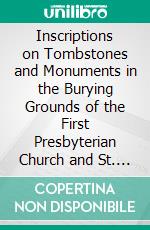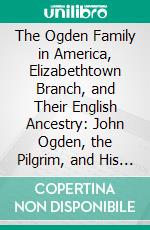William Ogden Wheeler eBooks
eBooks di William Ogden Wheeler di Formato Pdf
Inscriptions on Tombstones and Monuments in the Burying Grounds of the First Presbyterian Church and St. Johns Church at Elizabeth, New Jersey: 1664-1892. E-book. Formato PDF William Ogden Wheeler - Forgotten Books, 2017 -
The settlement of Elizabethtown was the first within the bounds of New Jersey made by New England people. The Purchase of the land from the Indians was made by John Baily, Daniel Denton and Luke Watson of Jamaica, L. I., October 28, 1664, and the Patent granted by Gov. Nicolls to Capt. John Baker, John Ogden, John Baily, Luke Watson "and their associates," confirming the Indian deed, bears date December 1, 1664. John Ogden of Northampton had bought out Denton's interest, and Capt. John Baker of New York was probably allowed an interest in consideration of his services as interpreter. Gov. Nicolls when he signed this patent was no doubt ignorant of the deed from the Duke of York to Berkley and Carteret made on the 24th day of June previous. Dr. Hatfield in his history of Elizabeth, thinks it probable that a formal occupation was made upon the land between October and December 1664, and that occupation by actual settlers soon followed. Mr. William A. Whitehead, in his last edition of East Jersey under the Proprietors, gives proof that when Gov. Philip Carteret arrived in 1665, but four English-speaking families were to be found in New Jersey, pioneers of the Jamaica Colony. The patent granted by Governor Nicolls and the Indian purchase were relied upon in after years by the citizens as giving them a good title independent of that of Berkley and Carteret, but the latter grant was prior to the Nicolls patent and a vast amount of litigation was caused by these conflicting grants, lasting until the Revolutionary war put an end to it.The first meeting house was of wood and of a very humble style of architecture. It was replaced by a new church in 1724, fifty-eight feet in length and forty-two feet in width. An addition in the rear of sixteen feet was made in 1766. On the night of January 25, 1780, a party of British troops and refugees, numbering nearly four hundred, crossed on the ice from Staten Island to Trembly's Point and were led by three Elizabethtown tories by the nearest and most retired route to the town. Here they secured a few prisoners, plundered many of the inhabitants, burned the Court House and Meeting House, and retreated with haste by way of De Hart's Point without loss. Washington spoke of this event a day or two after as "the late misfortune and disgrace of Elizabeth Town." The erection of a new church was commenced in 1784, and completed in 1789. It forms a part of the present edifice, and was extended and improved many times before it reached its present dimensions.Dr. Kempshall in his historical discourse, delivered January 25, 1880, in celebrating the Centennial Anniversary of the burning of the church says:"The lot on which the house was built included the present burying-ground, and extended on the west to the river (so called), and contained about eight acres.
The Ogden Family in America, Elizabethtown Branch, and Their English Ancestry: John Ogden, the Pilgrim, and His Descendants, 1640-1906. E-book. Formato PDF William Ogden Wheeler - Forgotten Books, 2017 -
The system employed in compiling the genealogical section of this work is believed to be the most approved now ion use, and may readily be understood by a little study. The compilers have added new features which they believe will be found valuable, both in the body of the work and in the index. The ancestral chain, given after the name of each descendant having issue, shows the full line of descent at a glance. Each descendant has his own number. When descendants do not have issue, their full biography will be found connected with their names first mentioned, and in the consecutive small numbers.When a descendant has issue, his or her name is carried forward in the large numbers to the next generation, where the biography is fully given, followed by the list of his or her children.Each female line ends in the book with the grandchildren of an Ogden mother, but the line is continued in the charts, and without numbers.Where correspondents sent in tardy data concerning their families, and after the editors had systematically arranged the regular descendants by consecutive numbers, it became necessary to group the added names in the immediate family line, each child taking the parents number, with a letter of the alphabet annexed.In cases of intermarriage, and where there was issue, the person bearing the name Ogden, or the person first recorded in the regular line of ancestry, is usually the one carried forward to the next generation. To indicate specially the person carried forward, the cross-reference (See No.) is employed.The usual genealogical terms and abbreviations are used throughout the work, viz.: b. - born; cir., circ. - circa, about; d. - died; dau. - daughter; d.s. p. - died without issue; d. y. - died young; m. - married; s. p. –sine prole, without issue; unm. - unmarried; w. - wife; wid. - widow or widower.The editors do not assume that no errors are discoverable in this work. A number of conflicting statements sent by different correspondents, and a disagreement of old records, were often puzzling to the editors; but great care was exercised in settling upon what seemed to them the most authentic and trustworthy.

